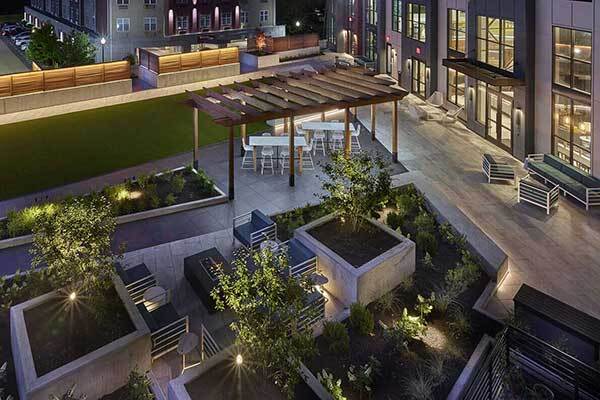Commercial landscape design is an essential aspect of creating an attractive and functional outdoor space for businesses. A well-designed commercial landscape not only enhances the visual appeal of the property but also contributes to a positive and inviting atmosphere. Here are key considerations for commercial landscape design:
1. Purpose and Goals:
- Define Objectives: Clearly outline the purpose and goals of the commercial landscape. Consider factors such as creating a welcoming entrance, providing outdoor seating, or incorporating green spaces for employee well-being.
2. Site Analysis:
- Study the Site: Conduct a thorough analysis of the site, considering factors like soil quality, drainage, sunlight exposure, and existing vegetation.
3. Zoning and Regulations:
- Understand Regulations: Familiarize yourself with local zoning regulations and building codes that may impact the landscape design. Obtain necessary permits for any construction or alterations.
4. Sustainable Design:
- Environmental Considerations: Incorporate sustainable design practices, such as native plantings, water-efficient irrigation systems, and energy-efficient lighting. This can enhance the property’s environmental sustainability.
5. Functional Spaces:
- Define Spaces: Plan and design functional outdoor spaces based on the needs of the business. This may include seating areas, walkways, gathering spaces, and recreational zones.
6. Plant Selection:
- Native Plants: Choose native plants that thrive in the local climate and require less maintenance. Consider seasonal interest and color for visual appeal.
7. Hardscaping Elements:
- Paths and Walkways: Design pathways and walkways that are accessible, well-lit, and ADA-compliant. Use materials that complement the overall aesthetic.
- Plazas and Courtyards: Integrate plazas or courtyards for communal gathering, events, or outdoor meetings.
8. Outdoor Amenities:
- Seating Areas: Provide comfortable seating options for employees and visitors. This can include benches, outdoor furniture, or even shaded seating structures.
- Shade Structures: Consider the inclusion of shade structures, such as pergolas, awnings, or trees, to provide relief from the sun.
9. Water Features:
- Fountains or Ponds: Incorporate water features for visual interest and a calming atmosphere. Consider the maintenance requirements and water conservation.
10. Lighting Design:
- Security Lighting: Ensure adequate lighting for security purposes, especially around entrances, pathways, and parking areas.
- Ambient Lighting: Incorporate ambient lighting to create a welcoming atmosphere during evening hours.
11. Branding and Aesthetics:
- Reflect Brand Image: Align the landscape design with the overall branding and aesthetic preferences of the business.
12. Maintenance Considerations:
- Low-Maintenance Design: Choose plants and materials that require minimal maintenance to keep the landscape looking pristine.
13. Accessibility:
- ADA Compliance: Ensure that the landscape design is accessible to individuals with disabilities, meeting ADA (Americans with Disabilities Act) standards.
14. Professional Assistance:
- Landscape Architect: Consider hiring a professional landscape architect or designer who specializes in commercial projects. They can bring expertise and creativity to the design process.
15. Long-Term Planning:
- Future Growth: Plan for future growth and changes in the business by allowing flexibility in the landscape design.
Commercial landscape design should align with the business’s identity, enhance functionality, and create a positive environment for employees, clients, and visitors. Professional expertise can play a crucial role in achieving a well-balanced and aesthetically pleasing commercial landscape.

